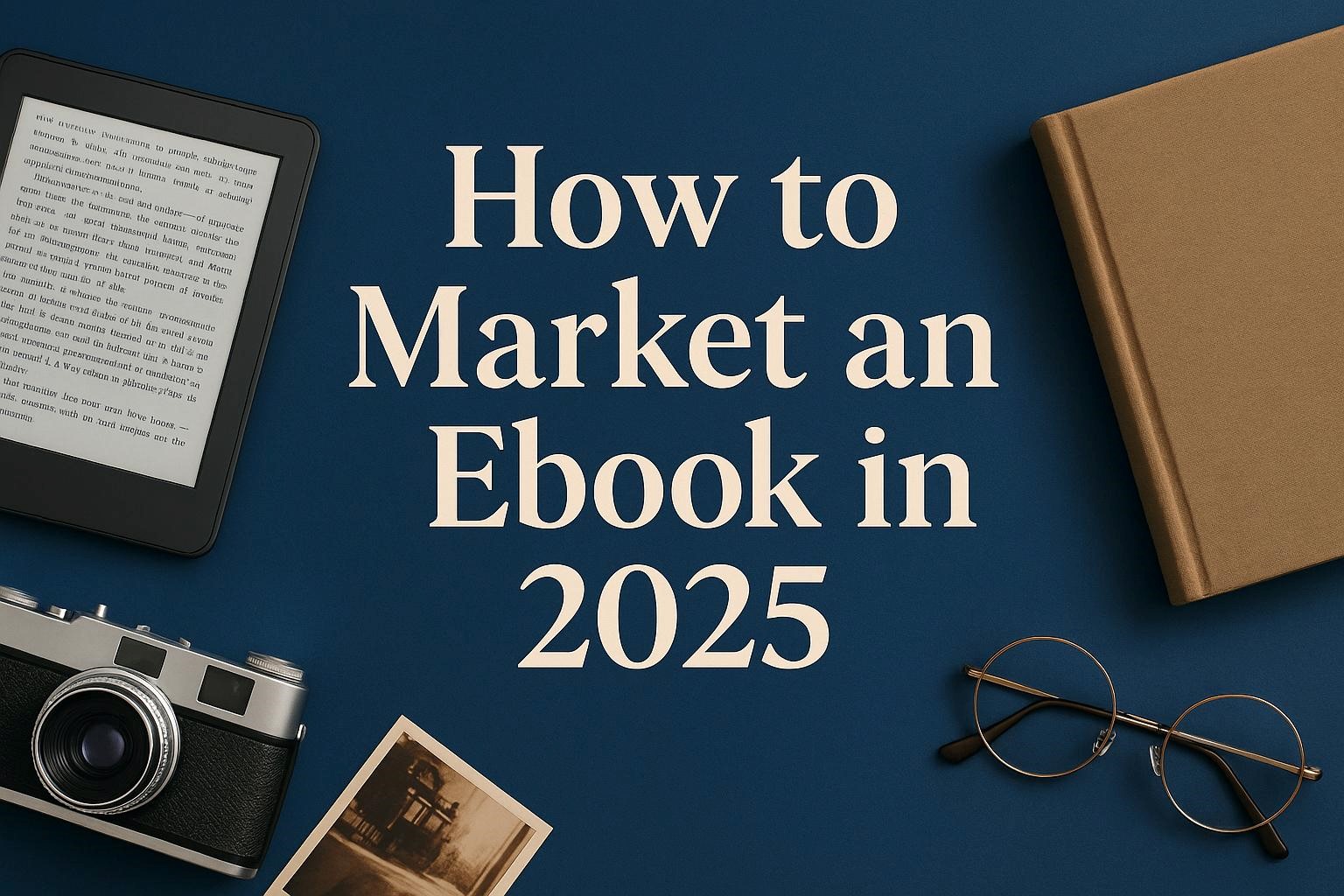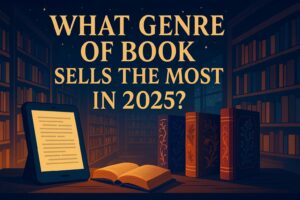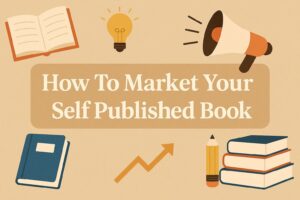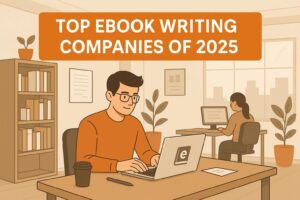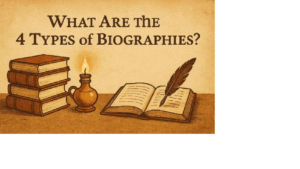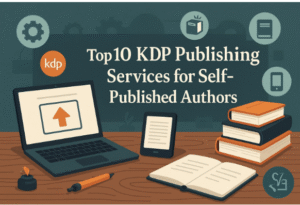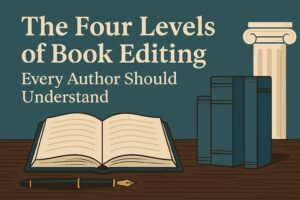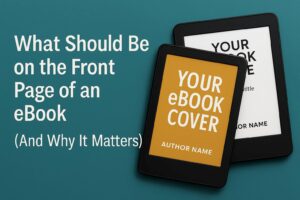Discover the most effective ways to market an eBook in 2025. From Amazon KU vs Wide distribution to promo calendars, ads, and seasonal campaigns, this guide covers everything authors need to boost sales and reach more readers.
Introduction
Writing an ebook is hard. Marketing it in 2025 is harder. Not because readers don’t want books, but because they are drowning in choice. Thousands of new titles go live every single day, and the quiet tragedy is that most of them vanish without ever being seen.
That’s not going to be your story.
The landscape has shifted. Bookshop.org now sells ebooks. Social media habits have stabilised. Amazon is still powerful but no longer the only game in town. And in the middle of all this change, authors like you are asking the same question: how to market an ebook in a way that actually works.
I’ve been inside this world long enough to know what’s noise and what’s real. I’ve watched launches flop, I’ve seen launches soar, and I know the difference comes down to strategy, not luck.
This guide will give you the clarity you’ve been searching for. You’ll walk away knowing what’s changed in 2025, how to pick the right sales strategy for your book, and how to create a launch plan that doesn’t just look good on paper but actually moves copies.
What’s Changed in 2025 (and why it matters)
Amazon is no Longer the Only Giant
For years, ebook marketing meant Amazon or nothing. That’s changed. Bookshop.org now sells ebooks through apps and browsers, giving you a fresh way to reach readers who want to support indie bookstores. This widens your distribution options and shifts how you think about format compatibility and audience targeting.
Social Media: Less Scatter, More Strategy
Authors used to burn out chasing every new network. In 2025, that approach is dead. Most writers are showing up weekly on just one or two platforms. The difference isn’t quantity, it’s focus. If your readers are on Instagram, lean into it. If they’re on TikTok, go there. Don’t try to do it all.
Evergreen Tactics Still Drive Sales
Trends come and go, but the basics haven’t budged. Metadata, keywords, categories, they still power discoverability. A clean description and sharp packaging still turn browsers into buyers. Before you get caught up in ads or ebook writing services, nail the fundamentals.
Balance New Opportunities With Old Truths
The big picture in 2025 is simple. The landscape is evolving. You have fresh tools and platforms. But the timeless principles of visibility and discoverability still matter. If you are asking how to promote an ebook right now, the winners are the authors who keep one foot in both worlds.
Decide Your Go-To-Market: Kindle Unlimited vs. Wide
Your first big decision as an author in 2025 is simple on the surface but massive in impact. Do you go exclusive with Kindle Unlimited, or do you go wide across every store you can reach? This choice determines your marketing plan, your promo calendar, and even the kind of readers you attract.
The Kindle Unlimited Path
Kindle Unlimited (KU) is Amazon’s exclusivity programme. When you enrol your book, you agree to sell it only on Amazon for 90 days at a time. In exchange, you unlock page-read income, promotional tools, and deeper visibility within Amazon’s recommendation engine.
Why does this matter? Because KU readers are voracious. Many of them consume multiple books a week, sometimes more. If you write in binge-friendly genres like romance, fantasy, or thrillers, KU can flood your book with reads you’d never see on a purchase-only model. Pair this with strong metadata work inside Amazon and you can create a self-sustaining flywheel of visibility.
But exclusivity has its cost. You miss out on readers who don’t buy from Amazon. You can’t run promos on Apple, Kobo, or Google Play. You also risk putting all your eggs in one basket, which can feel fragile if Amazon tweaks its algorithms.
The Wide Distribution Path
Going wide means publishing your ebook across multiple platforms: Apple Books, Kobo, Google Play, Bookshop.org, plus smaller stores through aggregators like Draft2Digital or PublishDrive. This approach diversifies your income streams and builds resilience against Amazon’s changes.
The advantage here is freedom. You can coordinate promos across platforms, run price drops on different stores, and even experiment with audience-specific bundles. Bookshop.org’s new ebook option also adds a powerful talking point: you can market your book as a way to support indie stores, which appeals to many readers.
The challenge? Wide distribution often grows more slowly. You don’t get the same instant algorithm boost that KU can provide. Instead, you’re playing the long game, cultivating steady income streams across multiple retailers. Patience pays off here, especially if you’re building a catalogue.
How to Decide What’s Right for You
There’s no one-size-fits-all answer. Ask yourself:
- Do I write in binge-heavy genres where KU readers dominate?
- Do I want the quick hit of Amazon visibility, or the long-term stability of wide?
- Am I comfortable committing to 90 days of exclusivity, or do I want maximum flexibility?
If you’re launching your very first book and need momentum, KU might give you the fast start you crave. If you’re building a long-term brand and want to control your reader relationships, wide distribution might be the better play.
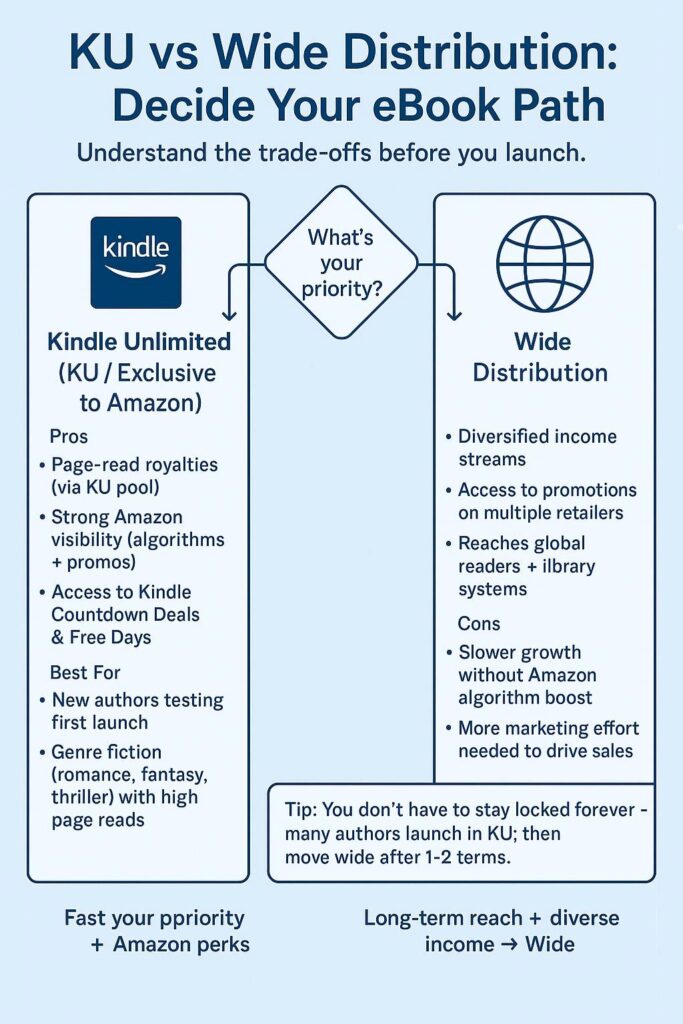
Action Step: Build a 90-day Calendar
Whichever route you choose, map out your first 90 days. KU authors should plan Amazon promos, Kindle Countdown Deals, and newsletter pushes aligned with algorithm triggers. Wide authors should coordinate price promos across Apple, Kobo, and Google Play, schedule submissions to promo directories, and create bundles to boost visibility.
Treat this as your launch runway. It’s easier to make smart choices when your actions are scheduled in advance instead of reactive.
Kindle Unlimited offers speed. Wide offers stability. Both can work, but the power comes from committing to one approach and structuring your launch plan around it. If you’re serious about growing, remember that strategy beats luck every time. And if you want more traction, layer in tried-and-true ebook sales tips like optimising your keywords, sharpening your description, and stacking promotions.
Nail the Storefront Fundamentals (conversion levers you control)
Before ads, before social media, before big promotions, your storefront is where everything succeeds or fails. Readers land on your product page, skim for a few seconds, and decide if they’ll buy or bounce. This means your most powerful conversion levers are the things you directly control: your cover, your description, your metadata, and your formatting.
Your Cover: The First Handshake
Your cover is not about artistic expression. It is about signaling genre, tone, and promise. If a reader can’t tell within one glance whether your book belongs to romance, thriller, or fantasy, you lose them.
Think of it like walking into a shop. If you see packaging that looks out of place, you’ll keep walking. Your cover has to match reader expectations while still standing out. If you can, look at the top 20 books in your category. What do their covers have in common? Color palettes, typography, character focus? Match the conventions, then add one element that gives you an edge.
The Subtitle and Hook
Many authors underestimate the subtitle. This is your chance to reinforce genre and hook. A vague subtitle wastes real estate. A strong subtitle tells the reader what kind of experience they’re about to have.
For example, “A Gripping Psychological Thriller” immediately tells the reader what to expect. That clarity can double your click-through rate.
Product Description: Your Silent Salesperson
Your description isn’t a blurb for friends, it’s sales copy. Readers skim. They don’t want long paragraphs. They want short, scannable leads that build curiosity.
Use bolding sparingly to highlight key phrases. Break text into 2–3 line paragraphs. Open with a hook, follow with a quick setup, and end with a call-to-action like “Perfect for fans of X and Y.”
And don’t stop after one draft. Test different versions. Swap your first line. Change your call-to-action. Small tweaks can create big lifts in conversion.
Metadata and Keywords: Invisibility or Visibility
Keywords and categories are what make your book findable. If your metadata is off, your book is essentially invisible. Research intent-driven phrases your readers actually type into search bars. Go beyond single words like “fantasy” and use longer phrases like “slow burn fantasy romance” or “space opera with strong heroine.”
Seasonal keywords also matter. If your book fits into “summer beach reads” or “holiday romance,” include those when relevant. Trends shift fast, so keep an eye on what readers are searching for and update accordingly.
Formatting: The Hidden Trust Signal
Formatting seems small, but readers notice. A poorly formatted ebook with broken links, strange spacing, or typos instantly destroys trust. And worse, it can lead to returns. Investing in professional formatting is not just about aesthetics, it’s about reader confidence.
Why This Matters
All the ads and promotions in the world won’t save a poorly optimized product page. If your cover, description, and metadata don’t convert, you’re pouring money into a leaky bucket.
When people ask how to market an ebook, the answer starts here. Nail the storefront fundamentals first. Once your foundation is strong, every click you earn from ads, email, or social has a much higher chance of turning into a sale.
Launch System: Preorder → Release Week → 30-Day Push
A launch is not a single day. It’s a system that unfolds over weeks, each stage designed to build momentum and visibility. In 2025, the authors who thrive are the ones who treat their launch like a campaign, not a calendar event.
The Power of the Preorder Runway (2–8 Weeks)
Your preorder window is the quiet buildup before the storm. It’s where interest turns into early sales, and those early sales turn into algorithmic momentum.
- Build an ARC team: Send advance review copies to engaged readers in your genre. Reviews on day one create credibility and momentum.
- Refresh your lead magnet: Update your freebie or reader magnet to point to your preorder link. Every new subscriber is a potential buyer.
- Newsletter swaps: Partner with authors writing in your niche. Promote each other’s books to expand reach and credibility.
- Retailer previews: If stores like Apple or Kobo allow early placement or preorder promotions, submit your book. Visibility begins before launch day.
- Early price promotions: Offer a small preorder discount to encourage urgency. Readers love feeling like they’ve secured a deal before everyone else.
Release Week: Your Spotlight Moment
This is where your preparation pays off. Your job now is to make your book impossible to ignore.
- Plan your email sequence: Send one announcement email, a follow-up with reviews or quotes, and a final reminder about your limited-time price.
- Test retailer ads: Launch small campaigns on Amazon or Apple Search to gather data on keywords, audiences, and conversion rates. If you’re using amazon book publishing services, take advantage of the built-in promotional tools like Countdown Deals and targeted ad placements to boost visibility.
- Show up consistently on social: Post across your chosen platforms, share snippets, celebrate reviews, and thank readers. Authenticity sells.
Spread your energy over several days. A single post on launch day will fade within hours, but steady presence creates ongoing momentum.
The First 30 Days: Visibility and Reviews
The first month defines your book’s long-term trajectory. This is when algorithms decide whether to keep recommending your book or let it sink.
- Rotate price promotions: Use 99¢ deals, free promotions, or tiered pricing to maintain attention. Combine them with reputable promo sites for maximum downloads.
- Leverage BookBub and similar platforms: Even smaller ad packages can put your book in front of readers who actually buy.
- Collect reviews actively: Encourage your ARC team and early readers to post feedback. Positive reviews act as social proof that drives conversions.
- Expand your partnerships: Appear on podcasts, join anthology collaborations, and cross-promote with authors writing in similar genres.
Why This System Works
A launch isn’t a one-day sprint. It’s a 30-day climb that builds traction, credibility, and sustained visibility. The preorder phase creates buzz, release week delivers sales velocity, and the first 30 days lock in momentum through reviews and algorithms. When structured correctly, this approach gives your ebook staying power instead of a short-lived spike.
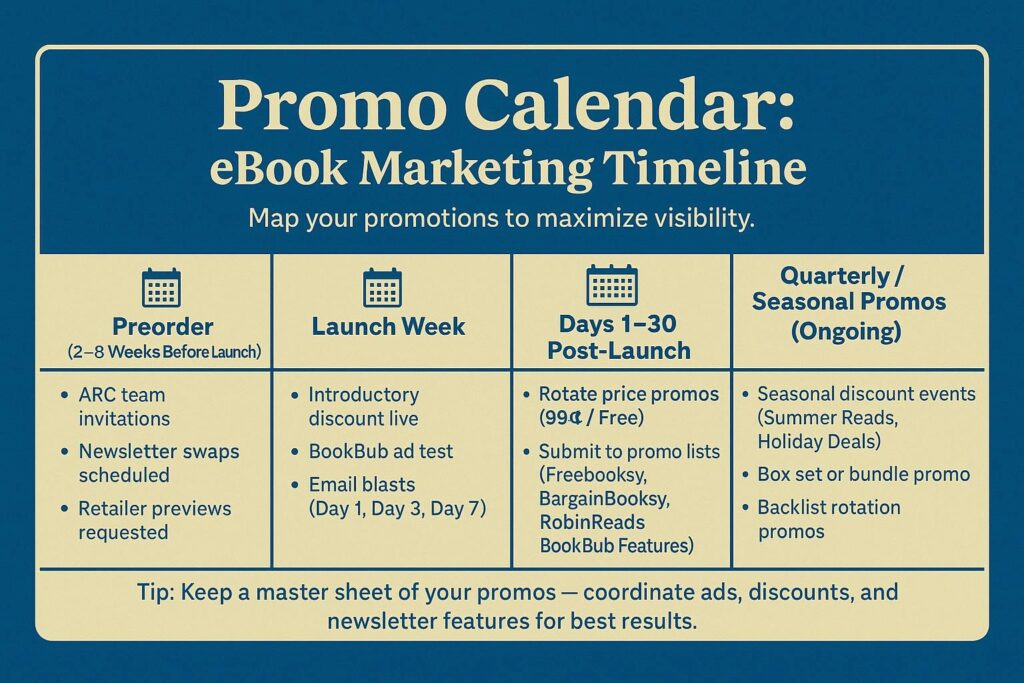
Paid Amplification That Actually Works in 2025
Paid advertising has always been a double-edged sword for authors. It can catapult your book into visibility, but it can also drain your budget fast if you don’t know what you’re doing. In 2025, the key to effective paid amplification is precision. You don’t need huge budgets or complex funnels. You just need to know where your readers actually spend time and how to reach them efficiently.
BookBub: The Power Buyer’s Playground
BookBub remains the gold standard for connecting with serious readers. Their Featured Deals still drive huge visibility, but they’re highly competitive. Even if you can’t land one immediately, their ad platform is a smart entry point.
- Start small: Test low-budget campaigns with focused targeting. Use book categories, author comp lists, and similar-reader audiences.
- Use price drops: Pair your ads with temporary discounts to spike downloads. The combination of ad exposure and lowered price can trigger store algorithms.
- Promote series strategically: If you write a series, advertise book one and mention the sequels. Readers who binge are your most valuable customers.
Meta Ads: Facebook and Instagram Still Work
Despite changes to privacy and algorithms, Meta ads remain one of the most versatile tools for authors. The trick is to lead with creativity, not complexity.
- Test creative angles: Instead of static covers, try quote snippets, mood imagery, or short video loops.
- Stack interests: Target readers who love specific authors or tropes. Combine small interest groups to create hyper-relevant audiences.
- Start tiny: A few pounds a day can teach you a lot. Let each ad run long enough to gather data before making changes.
- Avoid burnout: One strong, consistent ad will outperform ten poorly targeted ones.
Retailer Ads: Data That Pays for Itself
Amazon Ads, Apple Search Ads, and Kobo Promotions all let you target readers while they’re already in a buying mindset. That makes them some of the most conversion-friendly ad options available.
- Begin with automatic campaigns: Let the system find your initial data.
- Study what converts: Look for patterns in the search terms that trigger clicks and sales.
- Refine with manual campaigns: Once you know what works, run tightly targeted ads using the best-performing keywords and tropes.
Retailer ads also help build a feedback loop. When you see which keywords generate conversions, you can adjust your metadata to match, which improves both paid and organic visibility.
Blending Paid and Organic
Paid ads are powerful, but they work best when layered over strong organic foundations. An optimised storefront, consistent social presence, and an active email list amplify every penny you spend. If you’re wondering how to promote an ebook effectively in 2025, the answer isn’t choosing between ads and organic marketing. It’s learning to make them work together.
The Smart Ad Mindset
Don’t chase instant wins. Think in 90-day cycles. Test, measure, and adjust. Every data point tells you something about your audience, your creative, or your messaging. Paid amplification isn’t about luck. It’s about attention, iteration, and patience. When done right, it becomes a steady engine that powers both launches and long-term visibility.
Organic Growth Engines
Paid ads might create spikes in visibility, but organic growth is what keeps your book selling long after the campaigns stop. The authors who build sustainable careers know how to grow their audience naturally. It’s slower, yes, but it compounds. Each reader you earn through trust is a reader who sticks around.
Your Email List Is Your Number One Asset
If social media disappeared tomorrow, would you still have a way to reach your readers? That’s what an email list gives you: control, connection, and reliability.
- Build through value: Offer a lead magnet that aligns with your book. It could be a prequel, a bonus chapter, or even a character guide. Make sure it’s something readers actually want.
- Create a welcome series: Don’t stop at one confirmation email. Introduce yourself, share your story, and let new subscribers know what to expect from you.
- Promote regularly: Use your list to announce new releases, share updates, and spotlight older titles. Your backlist is an asset, not an afterthought.
Email lists convert far better than social posts because your readers have already raised their hands. They want to hear from you.
Social Media: Go Where Your Readers Are
Social platforms still matter in 2025, but chasing trends doesn’t. The winning authors pick one or two channels and commit to showing up consistently.
- Choose strategically: If your audience loves visuals, Instagram and TikTok are worth your time. If they prefer discussions and quotes, try Threads or Facebook groups.
- Post with purpose: Every piece of content should do one of three things: entertain, inform, or invite readers to act.
- Reuse content: Turn one short video into an Instagram Reel, a TikTok clip, and a YouTube Short. Efficiency matters more than volume.
Keep your content simple, genuine, and frequent. Readers connect to real people, not perfectly polished brands.
Partnerships That Multiply Reach
You don’t need to market alone. Partnering with other authors can expand your reach faster than any ad spend.
- Newsletter swaps: Exchange mentions with other authors who write in your genre. Their readers already love similar stories.
- Anthologies and bundles: Combine your book with others in themed collections. Shared visibility benefits everyone.
- Podcast guesting: Appear on niche podcasts to talk about writing, world-building, or your inspiration. It’s a direct line to new audiences who are already interested in books.
Partnerships bring exponential exposure because they build networks of trust among readers.
At Writers of the West, we also offer a bunch of different services and packages and have helped numerous authors become best-sellers globally. If interested in availing our book marketing services in USA or anywhere globally, get in touch.
Why Organic Growth Still Wins
Organic marketing may feel slow, but it’s what gives your author career stability. Paid ads come and go, algorithms shift, but your relationships with readers last.
If you’re searching for ebook sales tips that will matter years from now, this is it: focus on relationships, not reach. Build a mailing list, show up where your readers actually spend time, and partner with people who share your audience. When you do that, every launch gets easier, and every book you publish sells a little better than the last.
Price Promotions and Calendars
Price promotions are one of the most powerful tools in your marketing toolbox. They spark visibility, attract new readers, and trigger algorithms that can keep your book climbing the charts long after the discount ends. But to work, promos need strategy and timing, not guesswork.
Why Timing Is Everything
Not all months perform equally for ebook sales. Holidays, seasons, and even cultural trends affect buying behaviour. For instance, romance spikes in February, fantasy in winter, and thrillers in summer. Knowing when your readers are most active helps you plan your discounts for maximum impact.
A well-timed sale can double or triple downloads. A random one can vanish without a trace. The key is to think ahead, not react.
Build a Master Promotion Calendar
Create a spreadsheet that lists every major promotion window of the year. Include retailer events, holidays, and key reading seasons. Some platforms like Kobo and Apple offer curated promotions if you submit your book early, so planning ahead gives you an advantage.
Your master calendar should include:
- Retailer deal windows: Keep track of submission deadlines for Amazon, Kobo, Apple Books, and Bookshop.org.
- Seasonal events: Plan around holidays, summer reading months, and shopping spikes like Black Friday.
- Email promo sites: Schedule appearances on reputable newsletter lists such as BookBub, Freebooksy, or BookSends.
- Ad support: Coordinate ads to run alongside each price drop for the best visibility.
When all these elements align, your promotions stop feeling random and start creating rhythm.
Coordinate With Ads and Emails
Promotions don’t exist in isolation. Every price drop should be supported by an ad burst and an email push.
- Before the promotion: Tease the deal in your newsletter a few days ahead of time. Build anticipation.
- During the promotion: Run short ad bursts on Meta or Amazon to boost momentum.
- After the promotion: Follow up with readers who downloaded your book. Encourage reviews or offer another title at full price.
This full-cycle approach makes every sale more than a one-time event. It’s an opportunity to deepen engagement and move readers further into your world.
Combine with Professional Support
If you’re still figuring out how to market an ebook effectively, using trusted book marketing services can save you time and frustration. Many agencies specialise in running coordinated promotions, managing ad spend, and timing your campaigns for the best results. Think of them as amplifiers that help your strategy go further, not shortcuts that replace it.
The Long Game of Pricing Strategy
Promotions work best when they’re part of a larger rhythm. Alternate between regular pricing, short discounts, and occasional free periods to keep algorithms active and readers engaged. Over time, you’ll learn which price points convert best and which months bring the strongest sales.
When you treat your promotions as planned, cyclical events rather than random experiments, your sales stop spiking and dropping unpredictably. Instead, they start flowing like a steady tide. That consistency is what turns an author into a brand.
Selling Direct and Non-Amazon Options
Amazon still dominates ebook sales, but 2025 is proving that independence can be just as profitable. More authors are experimenting with selling directly to readers and exploring non-Amazon platforms that give them greater control, higher margins, and stronger relationships with their audience.
Why Sell Direct
Selling direct means readers buy straight from you, not through a retailer. Platforms like Shopify, Payhip, and Gumroad make it easy to set up your own digital store. You control the pricing, the branding, and the reader experience from start to finish.
When you sell direct, you earn more per sale since there’s no retailer taking a cut. But beyond profit, you also gain valuable data; names, emails, and purchase histories, that retailers never share. That data lets you market smarter, launch faster, and create personal connections that build long-term loyalty.
How to Build a Direct Store
You don’t need to be a tech expert to sell ebooks from your own site. Start with a simple setup:
- Pick a platform: Shopify offers polished storefronts, Payhip integrates easily with author websites, and Gumroad is perfect for creators just starting out.
- Bundle your offers: Sell your ebook as part of a bundle with bonus content or related titles. Readers love getting extra value.
- Create urgency: Run limited-time sales or launch-exclusive discounts to motivate immediate purchases.
- Add reader support: Include clear instructions for downloading and reading across devices to reduce friction and refunds.
The key is clarity. Make buying and downloading as simple as possible.
Bookshop.org: A New Non-Amazon Player
Bookshop.org, known for supporting indie bookstores, now sells ebooks too. Readers can purchase through browsers or apps while knowing their money supports local bookshops. For authors, this opens a whole new audience of readers who prefer to shop ethically and avoid Amazon.
Adding Bookshop.org to your distribution plan diversifies your income and strengthens your brand message. If you already highlight your indie values or community connections, this platform reinforces that narrative perfectly.
How to Integrate Direct and Retail Sales
You don’t have to choose between direct and retail sales. The smartest authors blend both. Here’s how:
- Use your direct store for launch bundles, box sets, or exclusive bonuses.
- Keep your retail editions for wide visibility across Amazon, Apple, Kobo, and Google Play.
- Sync your pricing so your offers stay consistent.
- Use your email list to drive traffic between both worlds.
Think of it as building an ecosystem rather than a single sales channel. Your direct shop feeds your brand. Your retailer presence feeds discoverability. Together, they create balance.
The Bigger Picture
Selling direct and exploring non-Amazon platforms isn’t just about more money. It’s about control. You own the customer relationship. You decide how your books are presented, priced, and promoted. In a market that’s constantly shifting, that independence is power.
If you want to future-proof your author business, start building those systems now. The sooner you begin, the more freedom and flexibility you’ll have when the next wave of industry change hits.
Content and Catalog Strategy
The most successful authors in 2025 aren’t chasing viral moments. They’re building catalogues; collections of books that feed into one another and keep readers coming back. Every new strengthens the old ones. Every series compound visibility. Your catalog is your greatest marketing asset.
Why One Book Is Never Enough
A single book can open doors, but a catalogue builds a career. When readers finish one title and immediately find another, your conversion rate doubles without extra marketing effort. That’s the secret behind sustainable sales.
Even if you write standalone stories, create connection points between them. Shared worlds, recurring characters, or similar tones help readers know what to expect from you. That familiarity builds loyalty.
Series Sell Better Than Singles
If you want reliable income, think in series. Readers love continuity. They want to stay in the worlds they fall in love with. Each new instalment reignites interest in the earlier books, which means every launch boosts your entire backlist.
To maximise results:
- Plan your series arc early: Know where your story is heading and when to release each part.
- Use cliffhangers wisely: Keep readers hooked, but deliver satisfying payoffs along the way.
- Box sets and omnibuses: Bundle completed series at a discount. This attracts binge readers and helps you hit store algorithms with stronger sales bursts.
Write With Market Awareness
You don’t have to chase trends, but you should understand them. Watch what’s performing in your genre. Look at top charts and blurbs. Analyse how titles, tropes, and covers shift over time. Then align your creative vision with what readers are already searching for.
Writing market-aware content doesn’t mean selling out. It means understanding demand. When you write books readers are already looking for, you’re not pushing uphill. You’re meeting them halfway.
Repurpose and Refresh Your Content
Your content doesn’t have to live in one form. A novella can become a prequel. A trilogy can become a box set. A short story can be a free magnet for new subscribers. Repurposing keeps your catalogue active and extends the life of every project you’ve written. Refreshing also matters. Update older covers, rewrite blurbs, and rework metadata every year or two. Small tweaks can breathe new life into backlist titles that have gone quiet.
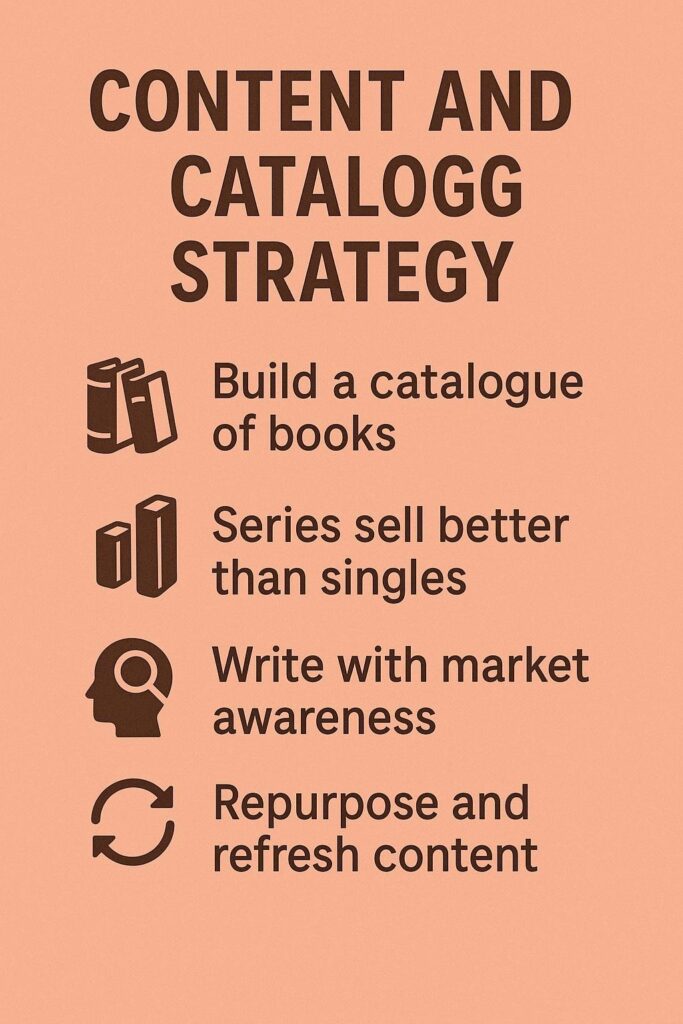
Why This Matters for Your Marketing
If you want to master how to market an ebook, start by thinking beyond your next launch. Marketing is easier when you have more books to promote, more series to cross-link, and more stories to offer loyal readers. Each book becomes both a product and an advertisement for the next.
Your catalog is proof of consistency. It shows readers and retailers that you’re not a one-time author but a growing brand. The bigger your catalogue, the smaller your dependence on luck.
The Long-Term View
Content and catalog strategy isn’t glamorous, but it’s what separates short-term visibility from long-term success. Keep writing, keep refining, and let every book strengthen the one before it. In 2025 and beyond, the authors who win are the ones who think in years, not launches.
Measurement and Iteration
Publishing an ebook without tracking your data is like sailing without a compass. You might move, but you’ll have no idea whether you’re heading toward success or drifting off course. In 2025, measurement and iteration are not optional. They’re the tools that turn guesswork into growth.
Why Data Matters More Than Ever
Every click, every download, and every ad impression tells a story. If you pay attention, you’ll start to see patterns; what readers respond to, what falls flat, and where your marketing actually earns results.
The authors who treat data as feedback, not judgment, are the ones who improve with every launch.
Key Metrics to Track
You don’t need to measure everything, but you do need to track what truly matters. Focus on the numbers that reflect reader behaviour and profitability.
- Click-through rate (CTR): Measures how many people click your links from ads, emails, or social posts. Low CTR means your message needs work.
- Conversion rate: Tracks how many of those clicks become sales. This shows how persuasive your storefront and description are.
- Read-through rate: Especially important for series authors. It tells you how many readers go from Book One to Book Two and beyond.
- Return on investment (ROI): Compare how much you spend on ads to how much you earn back. Adjust accordingly.
- List growth and engagement: Your email list is your core audience. Watch your open and click rates over time.
These numbers aren’t just statistics. They’re a map showing where to double down and where to pivot.
How to Apply What You Learn
Measurement is only half the job. The real magic happens when you iterate, when you make changes based on what the numbers reveal.
If a cover isn’t converting, redesign it.
If an ad audience stops working, test a new one.
If a series loses momentum, experiment with pricing, metadata, or a fresh hook.
Iteration turns short-term campaigns into long-term systems. It’s what allows you to grow smarter instead of just working harder.
Reinvest in What Moves the Needle
Not every marketing effort deserves equal attention. Once you know which actions drive sales, reinvest your time and budget into them. Maybe it’s retailer ads, maybe it’s email promos, or maybe it’s partnerships that bring consistent traffic. Whatever works, do more of it.
And don’t be afraid to pause what doesn’t deliver. Stopping the wrong tactics frees up energy for the right ones.
The Bottom Line
The authors who master how to market an ebook aren’t the ones who try everything. They’re the ones who measure, test, and refine. They use data to guide their next move, and they treat every launch as a chance to improve.
Publishing success in 2025 is not a mystery. It’s a process; a loop of learning, adjusting, and evolving until your results match your goals. Once you embrace that, growth stops being a guessing game and starts becoming a rhythm you can control.
FAQs
1. What are the highest-leverage marketing tasks for a 2025 ebook launch?
Focus on the essentials that give you the most return for your effort. Optimize your metadata; keyword and categories, because that determines how your book gets discovered. Build and activate your email list so you have direct access to your readers. Schedule coordinated price promotions using reputable newsletter services, and start small with test-driven ads on BookBub or Meta before scaling up.
2. Is Amazon still essential for ebook marketing?
Yes. Amazon remains the largest ebook marketplace, but it’s no longer your only option. In 2025, credible alternatives such as Bookshop.org and direct-selling platforms have created more freedom for authors. You can still succeed on Amazon, but don’t be afraid to explore hybrid strategies that combine Kindle Unlimited exclusivity with wide distribution.
3. Do social platforms still matter for authors of ebooks?
Absolutely. Readers still discover books on social media, but focus matters more than volume. Choose one or two platforms where your readers already spend time and post consistently with clear calls to action. Authentic engagement beats scattered posting every time.
4. Are price promotions worth it in ebook marketing?
Yes, when done right. Coordinating your deals with ads, email pushes, and promo sites can spike visibility and attract reviews. These boosts often trigger store algorithms, which help your book reach even more readers. For backlist titles or series openers, price promos can breathe new life into older releases.
5. What budgets should I expect for ads when marketing my ebook?
Start small. Even five to ten pounds a day can generate valuable insights. Use early campaigns to learn which creatives and audiences convert before scaling your budget. The goal is not to spend big but to spend smart. Once your return on investment is stable, you can gradually increase your daily ad spend.
6. How do I succeed if I’m not exclusive to Amazon?
Go wide with intention. Publish on Apple Books, Kobo, Google Play, and Bookshop.org, and coordinate promotions across all platforms. Use email and social campaigns to drive readers to the stores where they prefer to buy. You’ll gain more flexibility, multiple revenue streams, and insulation from algorithm changes.
7. What should my 90-day plan for ebook marketing include?
Think of your first 90 days as three distinct phases.
Preorder: Build excitement with ARCs, newsletter swaps, and preorder promos.
Launch Week: Run ads, send email sequences, and post actively on social media.
First 30 Days: Rotate price promotions, request reviews, and test ads for scaling.
When combined, these phases create a system that builds momentum and visibility that lasts.
Conclusion
Marketing an ebook in 2025 is about clarity, consistency, and connection. Success comes from strategy, not luck. From understanding your readers and refining your systems over time. You’ve learned how to structure launches, balance paid and organic growth, and build a catalogue that keeps selling. When in doubt, return to the basics: optimize your foundations, track your data, and stay consistent. Once you master how to market an ebook, you’ll see it’s less about chasing algorithms and more about building genuine connections with readers who will champion your stories long after release day.
If you are in search of the top book marketing companies, get in touch with us today.

